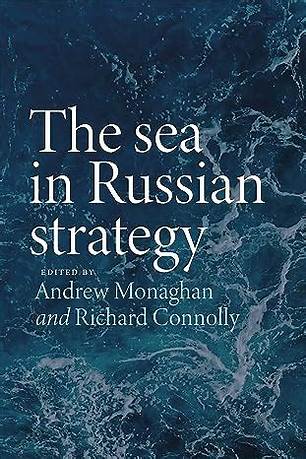
The Sea in Russian Strategy. Andrew Monoghan and Richard Connolly eds. Manchester University Press, Manchester 2023
Reviewed by Tim Coyle
Russia has largely been regarded in history as a land power; unsurprising at first impression by its geographic size. Peter the Great championed a Russian navy and the czarist era saw the growth of the navy, which many regarded as an expensive luxury fit only for the monarch’s prestige in international posturing. The Russo-Japanese war, and the ignominious defeat at the 1905 naval battle in the Tsushima Strait, was the lowest point of the Imperial Russian Navy.
The Russian navy’s main role in the 1917 revolution was the mutinying of its sailors, and the cruiser Aurora firing a few blanks at the Winter Palace in St Petersburg. In post-revolutionary Russia the navy played a secondary role to the Red army through to the 1941-1945 Great Patriotic War. Postwar, Stalin hatched ambitious plans for a battlefleet; however, these aggrandisements lapsed on his death. It was Admiral of the Fleet of the Soviet Union Sergey Gorshkov who politically outmanoeuvred his Politburo army colleagues to develop a powerful navy second only to that of the United States in the Cold War.
The Soviet navy collapsed with the Soviet Union in 1991 and became a ramshackle, corrupted and largely ineffective force which disappeared from the far seas. However, the Russian navy is back – credited to Vladimir Putin’s military reforms of the early 2000s and Russia pulling itself out of its post-Soviet torpor.
The Sea in Russian Strategy introduces us to the Russian Federation Navy (RFN) in its reinvigorated form. It comprises three Parts: Part 1: Maritime Strategies in the Historical Context, Part II: Russia’s Maritime Strategies and Capabilities Today and Tomorrow, and Part III: The Challenge: the Russian Navy in Practice. Each part consists of essays by maritime strategists and commentators.
Russia’s maritime strategy is a wholistic concept. It includes research and mercantile assets to develop and secure the near seas, particularly the Northern Sea Route, which is becoming more accessible with localised global warming.
The Sea in Russian Strategy presents a ‘three tiered’ profile of Russian naval power; a powerful submarine force of new construction SSBNs (Borei), and SSGNs (Yasen), together with upgraded legacy units, a fleet of frigates and smaller combatants, and nuclear ice breakers and research vessels. The RFN combatants (surface and subsurface) are largely configured to fire the Kalibr long range cruise missile (termed ‘Kalibrisation’). The 3M-14 land attack cruise missile, with a range of 2000-2500 kms, can reach the whole of Europe from the near seas, such as the Black Sea or the Baltic. The 3M54 anti-ship cruise missile has a range of 600 km with a terminal velocity of Mach 2.9. The missile tubes can also fire the older Onika anti-ship missile and the forthcoming Tsirkon hypersonic missile (500 km at Mach 8.0). These highly capable missile families permit the RFN to re-equip with smaller, cheaper, and more flexible surface combatants, as well as the formidable subsurface assets.
Notable is the lack of large combat units, both current and projected. The sole aircraft carrier, Kuznetsov, is essentially moribund and, while two of the original four-unit Soviet-era Kirov-class nuclear battlecruisers are programmed to be retained and upgraded, the ships’ ages and long period of inactivity may mitigate against this.
The contributors assess the RFN as a powerful force, occupying the third place in world navy rankings. The RFN can defend the homeland, overwatch the SSBNs in their ‘bastions’ and enforce national interests in the contiguous seas of countries with which Russia exerts influence. Its subsurface special forces are a threat to world communications links, while the apocalyptic Poseidon nuclear torpedo is an unknown quantity – whether it is a reality, or a propaganda phantom is disputed among Western commentators.
The Chapters on Russia as a Maritime Power and Russia’s Future Naval Capabilities provide a precis on RFN, and wider maritime forces construction, at various shipyards and review their overall efficiencies. They supplement the analysis of Russian maritime strategy and operational capabilities.
The RFN’s performance in the Ukrainian war is being closely watched. That Ukraine, effectively without a formal navy, has managed to destroy several surface combatants and a submarine (admittedly in dock) by uninhabited surface vehicles, thereby achieving a measure of sea denial, may portend the future in naval warfare. Vice Admiral Clive Johnstone RN – in the Chapter Russian Strategy and Power at Sea: Should we care? – writes that Russia views the West as a destabilising influence in international affairs with its repeated interventions and challenges to Russia itself. This is a continuation of the Cold War rationale which Russia maintained during the West’s self-perception of the ‘peace dividend’ following the collapse of the Soviet Union. Johnstone goes on to say that, for Moscow, the war in Ukraine represents the Great Power Competition made real. Despite Russia’s heavy materiel and personnel losses, its historical and spiritual belief of itself as a great power persists; it has entered a long-term struggle to globally re-establish its hegemony, of which strategic waterways are integral.
Contributors to The Sea in Russian Strategy include such maritime strategy and history luminaries as Geoffrey Till, Andrew Lambert, the above-mentioned Clive Johnstone, and naval history academics and directors of Russian strategic analysis institutes.
The Sea in Russian Strategy is a timely contemporary analysis of the 21st century RFN in its overall Russian military and strategic setting. It is worthy of close study.



